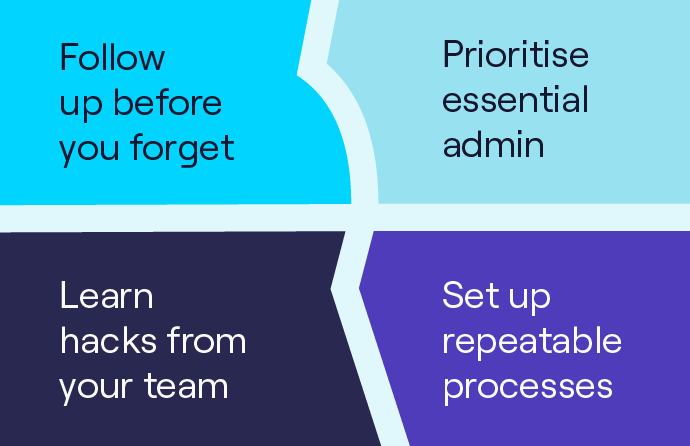How to Identify and Solve B2B Customer Pain Points
“Hello, sir or madam. Would your company be interested in signing up for our product or service?”
“Yes, please, we would love to. Where do I sign?”
- No sales call, ever! 😆
If only B2B sales were that easy! Unfortunately for sales reps, prospective customers always have pain points and objections. As a rep, you must be able to identify and solve customer pain points whenever they arise.
Sounds like a tall order? Well, we’ve got some expert help - Hugh Campbell, Cognism’s former Global Inbound Manager and Nancy Newman-Oller, Head of Account Management.
They’ll share the most common B2B customer pain points and give pointers on how to resolve them.
Scroll 👇 or use the menu to jump to a section.
How to identify B2B customer pain points
For Nancy, identifying customer pain points in B2B sales all comes down to the questions you ask. She said:
“Be curious and ask questions. Salespeople are in such a lucky position - we’re always speaking to people we can learn from.”
“Try to understand your prospects and build a relationship with them. If you can do this, they’ll be more open with you, and you’ll be better positioned to help with their pain points.”
As for the best questions to ask to uncover customer pain points, here’s a list you can use on your calls:
- What are the most significant challenges you face in your industry/business right now?
- Are there any specific tasks or processes that you find time-consuming or complicated?
- What are your top priorities when it comes to improving your business operations or outcomes?
- How do you currently address or cope with the challenges you encounter?
- Have you considered any solutions to overcome your challenges? If so, what factors have influenced your decision-making process?
- What features or functionalities are you looking for in a product/service that would best meet your needs?
- How do you measure the success or effectiveness of the products/services you currently use?
- What factors do you consider when choosing a vendor or partner for your business?
- How do you prefer to receive support or assistance when encountering issues with products/services?
- How do you envision your ideal solution to your current challenges?
- Are there any specific pain points that you believe are unique to your business or industry?
- What are the consequences of not addressing these pain points?
However, solving business pain points isn’t just about asking questions. You have to actively listen to your customers’ responses and ask follow-up questions to dig deeper.
Your goal is to gain a comprehensive understanding of their pain and then position your product as the ultimate painkiller!
The most common B2B customer pain points
When speaking with prospects and customers, SDRs will encounter all sorts of customer pain points.
Hugh and Nancy gave us a list of the most common B2B pain points that their teams deal with every day.
Keep scrolling! 👇
Financial pain points
These pain points relate to budget constraints, high costs, and the need for cost-effective solutions that provide value for money.
Pain point examples:
- “We love your product, but the pricing is a bit high for our budget. Is there any way to make it more affordable?”
- “I’m concerned about the return on investment if we choose your service. How long does it typically take for customers to see significant cost savings?”
- “The subscription costs for your software are adding up, and we’re trying to manage our recurring expenses more efficiently.”
- “We have limited funds allocated for technology upgrades this year. How can your solution fit within our budget constraints?”
- “We have several competing priorities, and investing in new systems might need to be postponed until the next quarter.”
- “We’re a startup, and securing sufficient funding for growth is a challenge. Is there any flexibility in your pricing options for new businesses?”
- “We’re worried about potential cost overruns during this project. Can you help us estimate and manage expenses more effectively?”
Operational pain points
These include challenges related to inefficient processes, resource allocation, and sales productivity issues.
Pain point examples:
- “We have a lot of manual tasks that are prone to errors. Is there a way to automate these processes to improve accuracy and save time?”
- “Our data is stored in different systems, and it’s challenging to access and share information across teams. We need better data integration.”
- “Our legacy systems are outdated, and we want to modernise our technology infrastructure. Can your solution help us with that?”
- “Our workforce productivity has been declining, and we’re looking for ways to boost employee engagement and performance.”
- “Staying compliant with industry regulations is getting overwhelming, and we need help managing the regulatory burden.”
- “We’re having difficulty adapting to changes in the market and need solutions that can help us stay competitive.”
Technical pain points
These involve difficulties in integrating new technology with existing systems, software compatibility issues, or a lack of technical expertise.
Pain point examples:
- “We’re interested in your software, but we’re concerned about compatibility issues with our existing systems. Can it integrate seamlessly with our current CRM?”
- "Our IT team has expressed concerns about the security features of your product. How can you ensure the safety of our data?”
- “We’ve experienced software crashes and system downtime with other providers. How reliable is your solution, and what uptime can we expect?”
- “Our team lacks technical expertise, and we’re worried about the complexity of implementing your solution. How user-friendly is the onboarding process?”
- “We’re in a regulated industry, and compliance is crucial. How does your software adhere to industry standards and data privacy regulations?”
- “Our mobile workforce needs access to your software on various devices and operating systems. Is your application compatible with all major platforms?”
- “Our internal processes are heavily reliant on custom software. Can your solution be customised to fit our specific workflows and requirements?”
- “We’ve had issues with data loss in the past. How does your product handle data backups and disaster recovery?”
Personalisation pain points
These customer pain points occur when customers feel that your product/service doesn’t cater to their needs.
Pain point examples:
- “Your product seems great, but we’re looking for a more customised solution that aligns with our specific business processes. Can it be tailored to our needs?”
- “We’ve been using a competitor’s service, and they offered more personalised support. How does your company handle personalised customer assistance?”
- “Your platform is missing some essential features that are crucial for our business. Can those be added based on our requirements?”
- “Your pricing plans are fixed, but we need a more flexible subscription model that caters to the varying needs of our different departments.”
- “Our previous vendor offered personalised training sessions that were tailored to our team’s skill levels. Can you provide the same level of individualised training?”
- “Our industry has unique compliance requirements. How can your product accommodate our personalised compliance needs?”
Security/privacy pain points
These pain points occur when customers express concerns about B2B data security, privacy breaches, and protecting sensitive information.
Pain point examples:
- “We’re interested in your cloud-based solution, but we’re concerned about the security of our sensitive data. How do you ensure data protection?”
- “Our industry has strict compliance regulations. Can you guarantee that your platform complies with all the necessary security standards?”
- “We’ve experienced data breaches in the past with other vendors. How does your company prioritise data security and prevent unauthorised access?”
- “Our company operates globally, and we need to comply with various international privacy laws. How do you handle data privacy for customers in different regions?”
- “We handle sensitive financial information, and any security breach could be disastrous. How do you monitor and detect potential security threats?”
Regulatory/compliance pain points
These involve challenges in adhering to industry regulations, legal requirements, and compliance standards.
Pain point examples:
- “Our industry is heavily regulated, and we need a vendor that can help us maintain compliance with the relevant standards and certifications.”
- “We’re facing increasing pressure from regulators to ensure data transparency and accountability. How does your platform support these compliance needs?”
- “We have strict data retention policies to adhere to. Can your solution automatically manage data deletion and archiving according to these regulations?”
- “Our company operates internationally, and we need a solution that can adapt to different data protection laws in various regions.”
- “We require audit trails and detailed reporting for compliance purposes. Can your system provide comprehensive compliance reporting?”
- “Our industry faces frequent regulatory changes. How does your company stay up-to-date with these changes and ensure ongoing compliance?”
- “Our vendors are required to undergo security assessments. Can you provide us with the necessary documentation and information for these assessments?”
- “We must follow specific industry standards, such as ISO or NIST, to ensure data security. How does your product align with these standards?”
- “Our internal policies prohibit using vendors that don’t meet certain compliance criteria. Can you provide documentation to demonstrate your compliance efforts?”
- “We need to ensure that our customer data is adequately protected against data breaches. Can you offer breach notification processes and support?”
- “As a financial institution, we must comply with regulations like GDPR and CCPA. How do you help us manage customer data rights and requests?”
Competitive pain points
These customer pain points arise when customers are unsure of what makes your product/service different from the competition.
Pain point examples:
- “Your pricing is higher compared to your competitors. Can you justify the premium and explain how your product adds more value?”
- “Your competitors are offering more innovative features and functionalities. Can your solution match or exceed their offerings?”
- “We lost customers to a competitor because they offered a more personalised experience. How can your company help us improve customer satisfaction?”
- “Your competitors are offering discounts and promotions to attract new customers. Can your company provide competitive pricing to match or beat their offers?”
- “Our competitors have been launching successful go-to-market campaigns. How can your company help us do the same?”
- “We’re looking to expand our international presence, and our competitors seem to have a strong global reach. Can your company assist in expanding our operations?”
- “Our industry is evolving rapidly, and we need a solution that can adapt to emerging trends. How does your product stay ahead of the curve?”
Innovation pain points
These pain points happen when customers face challenges in adopting new B2B technology or seeking innovative solutions.
Pain point examples:
- “Our competitors are introducing cutting-edge technologies that are transforming the industry. How can your company help us stay innovative and relevant?”
- “We need to find new ways to address our customers’ evolving needs and preferences. Can your products or services offer innovative features that meet these demands?”
- “Startups with innovative business models are disrupting our industry. How can your company help us adapt and compete with these new players?”
- “We’ve been using the same product for years, and it lacks the latest advancements available in the market. Can your solution provide a more innovative approach?”
- “We’re interested in exploring new markets and business opportunities. Can your company provide insights on potential expansion strategies?”
- "We’re concerned about potential disruption in our industry. How can your company assist us in future-proofing our business through innovation?”
Scalability pain points
These relate to the need for solutions that can adapt and scale as a business grows and expands.
Pain point examples:
- “Our business is experiencing rapid growth, and we need a solution that can scale with our increasing data and user demands. Can your platform handle our growth?”
- “We’re planning to expand our operations to new markets, and we need a system that can support multiple locations and handle increased transaction volumes.”
- “Our current software is struggling to handle the growing number of users, leading to slow response times. Can your solution provide better scalability and performance?”
- “Our seasonal sales fluctuations create challenges in resource allocation. Can your platform scale up or down based on demand?”
- “Our current cloud provider is not offering the scalability we need. Can your company provide a more flexible and scalable cloud solution?”
- “We’re planning to acquire other companies, and we need a system that can integrate new business units seamlessly and handle the increased data load.”
- “As we expand internationally, we need a solution that can adapt to different languages, currencies, and regulatory requirements.”
- “We’ve faced challenges with our current software’s database limitations. Can your solution handle large datasets without performance degradation?”
- “We’re concerned about lead generation costs. Can your platform provide cost-effective scalability options as we grow?”
Cultural/organisational pain points
These pain points occur when customers feel your company’s culture or values don’t align with theirs.
Pain point examples:
- “We’re considering adopting your project management software, but our company has a unique organisational structure. Can your solution accommodate our specific setup?”
- “Our company values collaboration and open communication. Can your team align with our cultural values to ensure a smooth working relationship?”
- “Our company has a strict hierarchy, and decision-making processes can be slow. How can your company adapt to our organisational dynamics?”
- “We prioritise sustainability and eco-friendly practices. Can your company demonstrate a commitment to environmental responsibility?”
- “We’ve experienced issues with other vendors not understanding our company culture, leading to misalignment in our projects. How does your company ensure cultural alignment?”
- “Our team is highly diverse, and we need a solution that supports multilingual and multicultural communication.”
- “We’re a family-owned business, and we value long-term relationships. Can your company provide personalised support and attention?”
- “Our company is known for innovation and out-of-the-box thinking. Can your team provide creative solutions that align with our organisational culture?”
- “Our employees have a strong focus on work-life balance. Can your company offer flexible arrangements to accommodate this value?”
- “Our company has a decentralised decision-making structure, which can lead to conflicting priorities. How does your solution ensure alignment across different departments?”
- “We’ve experienced issues with communication breakdowns in the past. Can your company provide tools and processes to foster effective communication?”
The best strategies for addressing B2B customer pain points
Hugh Campbell had this to say about solving customer pain points:
“In SaaS sales, you must put the customer first and tackle their pain points head-on.”
“The key is to really listen to what they need and come up with personalised solutions. It’s how you build trust and create lasting partnerships.”
Here are the best strategies to follow:
1. Research the customer and their industry
The first step is to find out all you can about the customer’s industry.
To soothe their pain points and handle their objections, you must demonstrate a deep understanding of their challenges.
Example:
A salesperson for an IT help desk support services company prepares for a meeting with a manufacturing company by studying industry trends, challenges, and competitors.
During the meeting, the salesperson shares insights and best practices from similar manufacturing clients, addressing the customer’s pain points with relevant solutions.
2. Active listening and assessing needs
On your calls and sales demos, you must listen attentively to the customer’s concerns.
If you don’t pay attention to their pain points and challenges, you’ll miss vital information that’ll help you close the deal.
Example:
During a sales meeting, a salesperson for a software company listens to a customer’s frustration with their current CRM system. The customer is unimpressed with its lack of automation, which leads to inefficiencies and manual data entry.
The salesperson takes notes and asks discovery questions to understand the customer’s pain points better. Then, the salesperson can start to address their pain.
3. Communicate clearly and transparently
You must always be transparent about what your product/service can and can’t do.
Don’t make unrealistic claims, and always manage customer expectations.
Example:
A salesperson for a sales automation platform tells a customer that while their product offers data enrichment, it doesn’t handle forecasting.
The salesperson solves this pain point by explaining how the product integrates with existing forecasting tools. This addresses the customer’s automation needs.
4. Provide tailored solutions
Personalisation is king in B2B sales!
You must craft personalised value props that directly address your customer’s pain points and showcase your solution’s benefits.
Example:
A salesperson for a logistics company presents a tailored proposal to a customer who’s facing supply chain disruptions.
The proposal highlights how their advanced tracking technology and efficient routing can help customers overcome logistics challenges and ensure on-time deliveries. Thus, the customer pain point is solved!
5. Offer proofs of concept and demonstrations
Real-world examples, demos and trials are great for showing customers how your product works and how it’s better than the competition at solving common pain points.
Example:
A salesperson for a cybersecurity firm sets up a demo showing how their product can protect the customer’s sensitive data from potential cyber threats.
The demo includes simulated scenarios, showcasing the solution’s effectiveness in mitigating security risks.
6. Share customer testimonials and case studies
Always have customer testimonials, reviews and case studies on hand. They tell prospects how people from other companies have succeeded with your solution.
Example:
A salesperson for a customer relationship management (CRM) software company is speaking with a finance company’s CEO.
The salesperson shares testimonials from similar finance clients who improved customer retention and productivity using the platform.
7. Run smooth post-sales support and follow-up
The sales process doesn’t end when contracts are signed!
Ensure ongoing support and follow-up after the sale; work with your customer success team to address any remaining customer pain points and build a long-term relationship.
Example:
After implementing a project management system like Function Point, a salesperson checks in with the customer quarterly to gather feedback and address any issues that may arise.
This ensures the customer’s pain points are continuously addressed.



